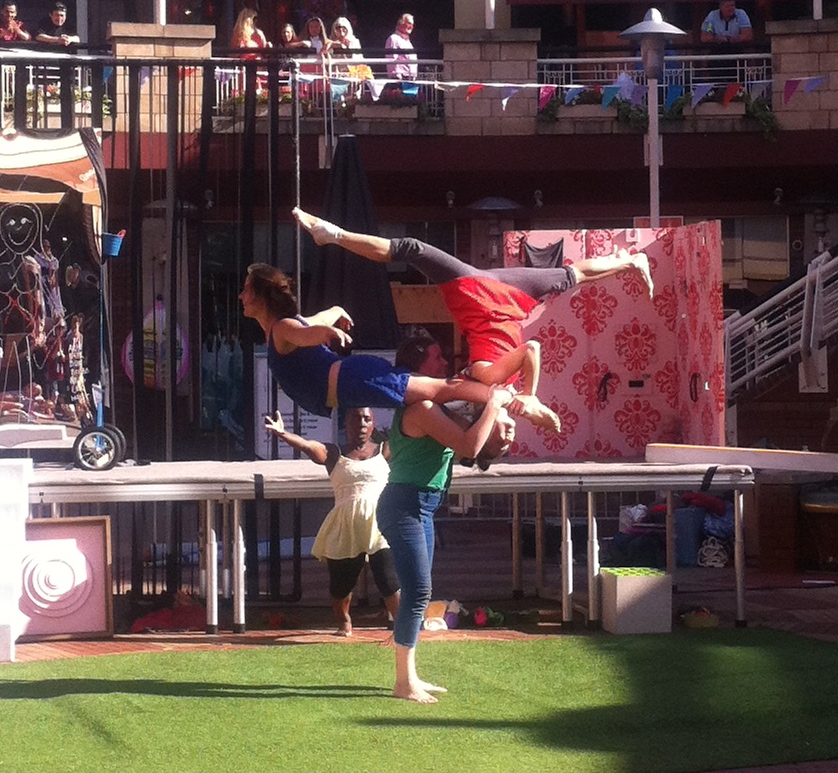The Arcadian, Birmingham, 3rd August
A strange array of oddments have taken over the central square of the Arcadian centre as part of Birmingham Hippodrome‘s ‘Summer in Southside‘ open-air season; the sun shines down on Mimbre‘s square of astro-turf, scaffolded platforms decked with string and rubber strips, walls of distorting mirrors (which the passing children love), and four women preparing for their show ‘Falling Up’ – seemingly oblivious to the expectant crowds gathered outside of the traditional street performers’ circle of rope.
 One of the performers, hair wrapped up in a towel and bedecked with roses, comes forward to hand out flowers among the front rows, promising she’ll tell us what they’re for later. As she returns to the demarcated performance area, we see that an exaggeratedly cartoon-figured woman has been drawn onto a large free-standing mirror, alongside a list of female body parts. The performers inhabit their own individually coloured worlds amongst the set and begin to talk, taking body measurements, exalting the power of their physique and eating cake; a disinterested voice behind me comments, ‘I think it’s all about stereotypes of women’. Another man asks me if we’re supposed to know what’s going on.
One of the performers, hair wrapped up in a towel and bedecked with roses, comes forward to hand out flowers among the front rows, promising she’ll tell us what they’re for later. As she returns to the demarcated performance area, we see that an exaggeratedly cartoon-figured woman has been drawn onto a large free-standing mirror, alongside a list of female body parts. The performers inhabit their own individually coloured worlds amongst the set and begin to talk, taking body measurements, exalting the power of their physique and eating cake; a disinterested voice behind me comments, ‘I think it’s all about stereotypes of women’. Another man asks me if we’re supposed to know what’s going on.
Once this contextual frame has been established, we wait for the set to be rearranged and, in the new configuration, watch the women in two separate pairings perform their different hand-to-hand and acrobalance routines. The front row are instructed to throw their roses. And then there is more rearranging of the set.
 The balances presented throughout the show become more and more impressive, creatively incorporating two, three and four bodies into towering statues and playful shapes despite the gusting breeze; but, unfortunately, the show as a whole feels like a series of transitions, utilising the loose thematic of body acceptance as an excuse to get to the next display of physical prowess.
The balances presented throughout the show become more and more impressive, creatively incorporating two, three and four bodies into towering statues and playful shapes despite the gusting breeze; but, unfortunately, the show as a whole feels like a series of transitions, utilising the loose thematic of body acceptance as an excuse to get to the next display of physical prowess.
Performances are on a scale more suited to a studio theatre environment than the great outdoors and, aside from a few pointed moments of direct address, the cast – with the exception of Emma Norin, one of the company’s co-founders – tend to slip into a fourth wall isolation. There is little genuine communication with the audience except for a few wry glances from Alison Halstead, and from the highly expressive Norin – who seems to be thoroughly enjoying herself and shares everything with us (as the woman next to me puts it, ‘the green-top woman’s face is amazing!’).
As a street theatre performance, there is not enough to attract a passing crowd, and it was noticeable that the static audience was here in advance specifically to see the show, and people walking by weren’t drawn in to stop and watch. Had I not been here solely for this show, I would have walked on after a couple of minutes, feeling disengaged. The rousing soundtrack of acid-jazz, neo-classical fiddling and jolly oompah music composed by cellist Bela Emerson attempts to tie together the disparate sections of action but, whilst enjoyable to listen to, does not make up for the drops in energy and interest on stage.
 The production was disjointed and visually messy and, though the company stand out for their impressive acrobalance lifts and poses as ‘four strong women’, the show lacks in the dimensions of acting, dramaturgical structure and aesthetics. For me, the range of physiques we see in the four acrobats and the unique ways they can combine are interesting enough on their own, and would form a stronger show if the focus had been on the communicative possibilities of the movements themselves, rather than on conceptual frameworks that are never fully worked through.
The production was disjointed and visually messy and, though the company stand out for their impressive acrobalance lifts and poses as ‘four strong women’, the show lacks in the dimensions of acting, dramaturgical structure and aesthetics. For me, the range of physiques we see in the four acrobats and the unique ways they can combine are interesting enough on their own, and would form a stronger show if the focus had been on the communicative possibilities of the movements themselves, rather than on conceptual frameworks that are never fully worked through.


